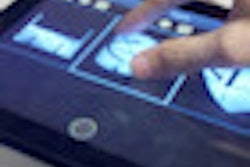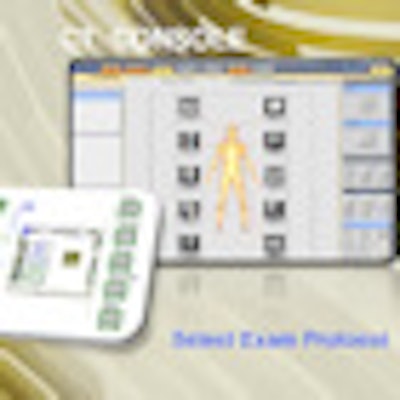
A new software-based training tool from the University of Chicago promises to train CT technologists in the complex procedure of virtual colonoscopy -- minus the image interpretation. The tool could help meet training needs should virtual colonoscopy come into widespread use for colorectal cancer screening.
The modular program, hailed as a big improvement over the hit-or-miss process of on-the-job training, relies on a knowledge base gathered through multiple sources in literature, interviews, and observation. The new tool includes videos, question-and-answer sessions, and realistic operator controls covering every facet of performing the virtual exam.
Created with the help of two off-the-shelf software building tools, the simulation software provides an algorithmic representation of a wide range of possible clinical scenarios. The tool was reviewed for ease of use and content by two experienced technologists, who gave it high marks for training efficiency while offering a few recommendations for improvements, according to radiologist and lead investigator Dr. Michael Vannier from the University of Chicago.
Vannier, who led the development process, said the software is easily adaptable to multiple vendors and could help train large numbers of technologists quickly when procedure volume for virtual colonoscopy (also known as CT colonography or CTC) eventually ramps up in the U.S., after what many believe is the inevitable eventual approval of VC reimbursement.
"This is going to become very important if CTC gets approved for screening," Vannier said in an interview with AuntMinnie.com. "All of the sudden a lot of people are going to have to do this, and we think it will be very handy for them."
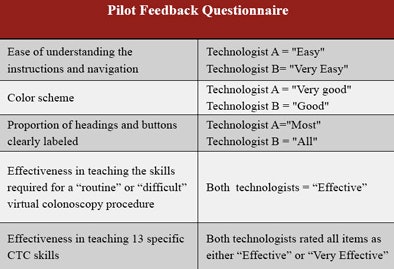 |
| Feedback from two expert technologists who performed a preliminary review of the system was mostly positive. All images courtesy of Dr. Michael Vannier. |
Learning unique skills
Setting patients up for virtual colonoscopy exams requires technologists to learn "unique skills that are not normally part of their training," Vannier said. Prior to scanning, for example, the colon must be insufflated with CO2, usually with the aid of an automated insufflator, and optimizing the insufflation process is complex, as is using the correct scan parameters.
To be sure, there are expensive training programs designed for radiologists that focus on exam interpretation over the course of a few days, but there is nothing geared specifically toward technologists, Vannier said. Courses for radiologists typically include a lecture on exam performance, but the fine-tuned skills required to optimize colon insufflation and other details for which technologists are normally responsible aren't included in these programs.
CTC is especially tricky, Vannier said.
"It requires that the patient undergo a bowel prep, and it's a screening procedure so the patient needs some explanation of what's going on," he said. "You have to place a tube though their anus to distend the colon with gas, you have to use a specialized machine called an insufflator to put in the CO2, and then you have to do the procedure."
Colons must be properly distended, and that can cause some discomfort. The technologist "needs to know how much gas to administer and when the discomfort is too much, and what can cause a technical failure of the examination," he said. "All of these elements are essential for success in virtual colon imaging."
A technologist with coaching from an experienced radiologist can be very successful, he noted, but as procedure volumes increase, technologists need to be comfortable operating on their own, and less-experienced technologists will also need to learn how to perform the exam quickly.
Most technologists "have learned on the job, but they've learned by not succeeding all of the time," he said. "We wanted to show at every procedure what is the proper procedure, what you can expect, what could go wrong, how do you fix it -- the sorts of things that require concentrated effort on the part of the instructor."
The idea was to modularize training so the program could be completed in a few hours, and the technologist could stop if necessary and come back later to complete the program. The project was conceived by University of Chicago co-investigator Dr. Abraham Dachman, a professor of radiology and VC expert who has been looking for ways to provide IT-based CTC training to large numbers of technologists, Vannier said. His other co-investigators were Dr. Farid Dahi and Ademola Obajuluwa.
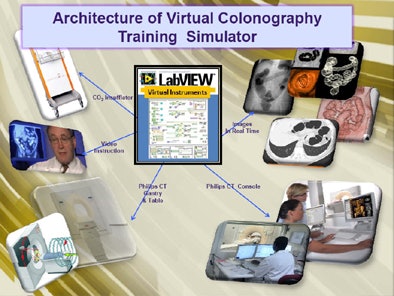 |
Putting it together
Simulation-based healthcare training has grown with the development of information systems to support it, Vannier said. Surgery and anesthesiology are the most common applications, but the technique is known to be an effective educational tool in a variety of applications.
The software tool was developed using Captivate (Adobe) software to simulate the decision points a technologist encounters when performing CTC. Captivate is primarily used for creating software demonstrations, simulations, branched scenarios, and quizzes in Flash format.
The software replicates the control panels on devices, which means that "now you don't need the instruments to simulate the CT scanner gantry and the insufflator," Vannier said. "You can turn the dials on the screen, you can push the buttons, the keyboard is active, just like it would be on the scanner," he said.
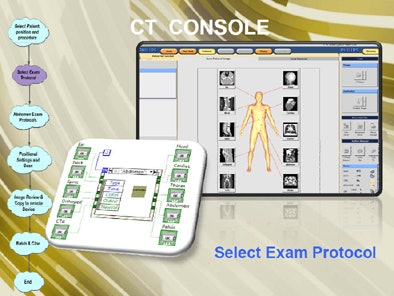 |
| Software-based functional mockup of CT scanner console for CTC training program (left) and real CT console (right). |
A technologist using the training program registers the patient, selects the proper protocol, acquires the scout image, and then plans exactly where the scan will be performed, Vannier said. Various elements of the training program are recorded on video, and all were developed as modules that can be separated as necessary within the interactive training course. Once the preliminary preparation is complete, "it shows a picture of the scanner scanning the patient," he said.
There are questions at every step of the way, too. "If [trainees] answer correctly, they're praised for that, but if they don't answer correctly, there are additional instructions for what to do, but you have to actually learn the material or you won't be able to do the whole thing," Vannier said.
After insufflation is complete, the program returns to the computer console, where the trainee pushes simulated buttons on the simulated CT scanner and performs the image acquisition. The system alerts the user instantly if a wrong button is pushed, he said.
A video crew was hired to make dozens of video sequences, and a voiceover expert did the narration. The two technologists who evaluated the system even performed in the videos: one became the patient while the other played the technologist in a no-holds-barred demonstration of tube insertion and CO2 insufflation. "It's all done very professionally," Vannier said.
Vannier's group is now working on wider dissemination of the tool.
"This was a research project done in a laboratory setting, but we've shown it to some people and it's gotten some interest, so we're talking to some vendors to see if they would be willing to distribute it," he said. The graphical user interface for the CT scanner is based on the controls of the department's 64-detector-row Philips Healthcare machine, but subsequent iterations can be modified for any scanner model. And, of course, the concept need not be limited to virtual colonoscopy.
"Once technologists get hold of this kind of thing, it may be useful for many of the kinds of procedures that we do that are a little more complex," Vannier said. The technologists will come out better trained than those who learn by trial and error. There's no rule requiring new technologists to "stumble up to the scanner" to clumsily perform their first procedures before becoming adept at a procedure, and simulation-based training can give them a head start, he added.
"I think it's enough that you can be much more confident when you approach the patient the first time or the first few times," he said. "If you have a large number of techs -- we've got 75 here -- and you're going to offer these procedures on a regular basis, you have to have some way to train people."







